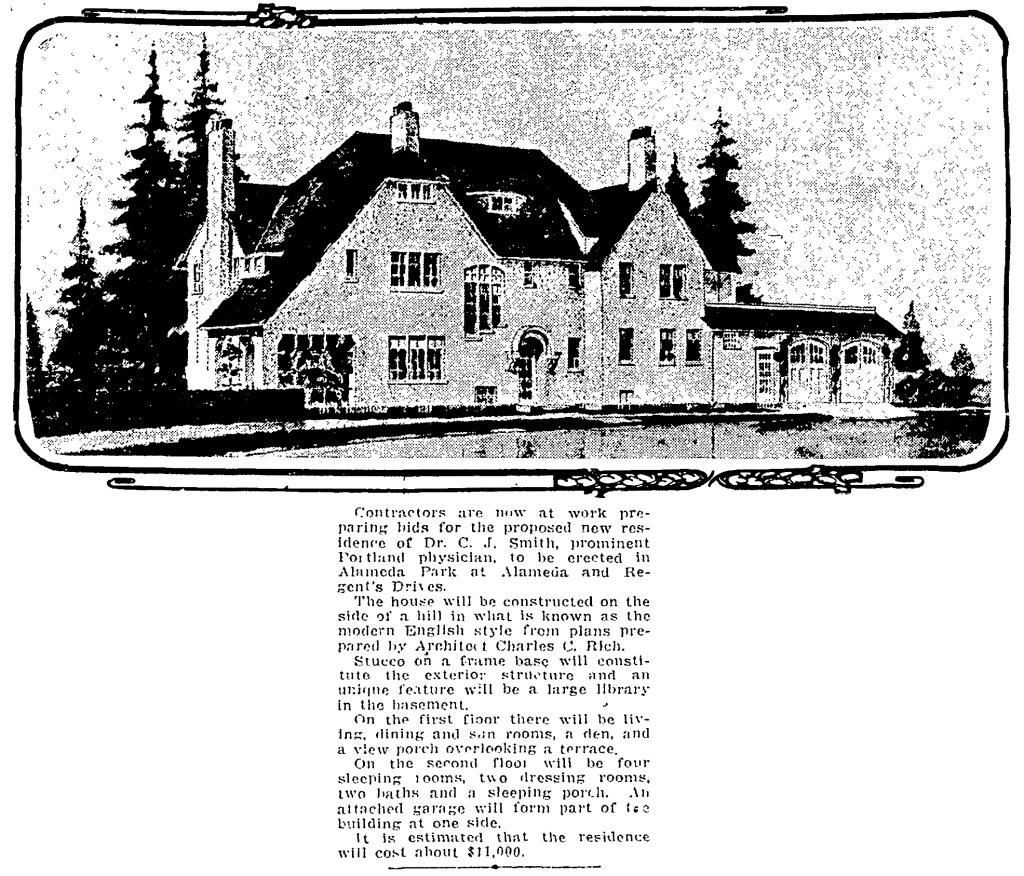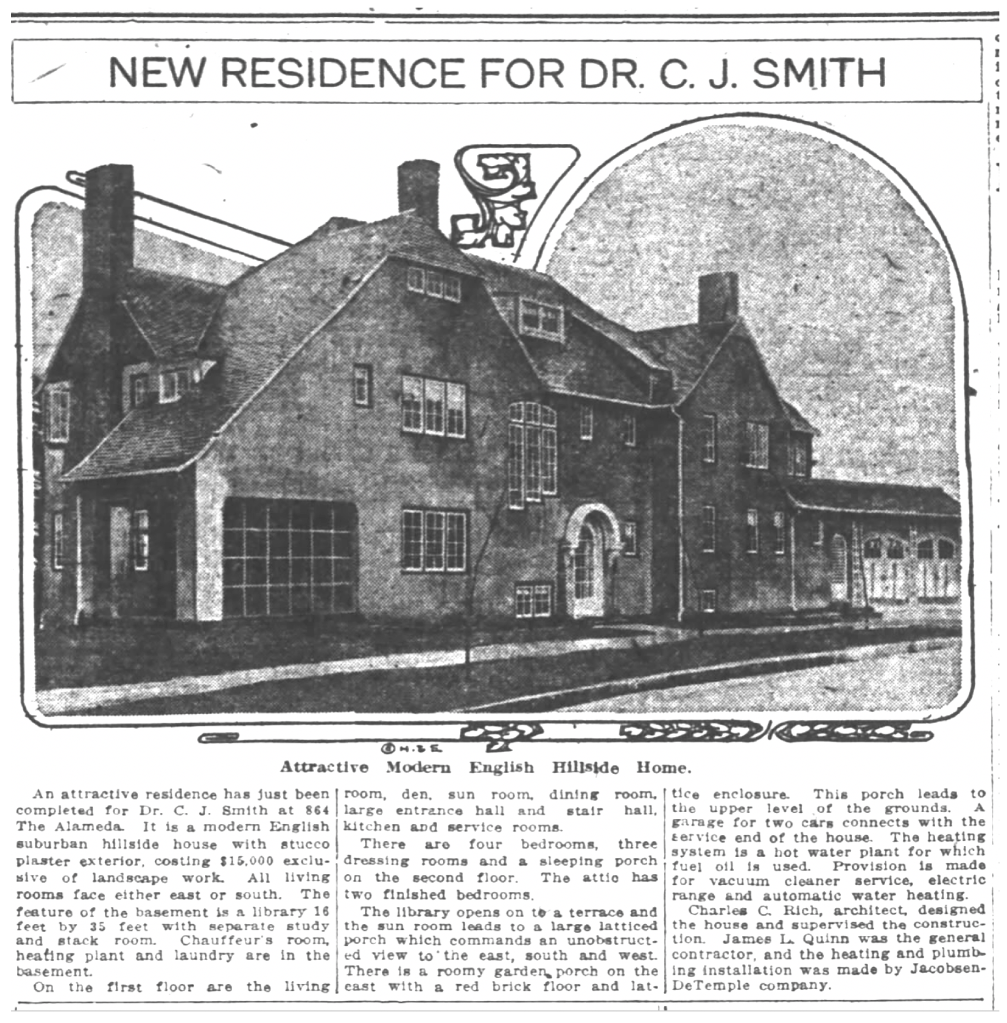When Dr. Charles Johnson Smith and Lillian Belle Guillford Smith built their mansion on Alameda Ridge in 1915, they had just come off his unsuccessful campaign for Oregon Governor, losing by a convincing margin to Republican James Withycombe, but considering a run for some other office or public service. They were also launching a new chapter in their lives—relocating to Portland from a quarter-century of public life and Dr. Smith’s medical practice in Pendleton.
Their new home at 864 The Alameda (readdressed during the Great Renumbering as 2834 NE Alameda) symbolized that ascendency: a graceful blend of English country house and Arts and Crafts style; a commanding view of downtown with a presence on the ridge among neighbors who were the captains of industry and Portland society; plenty of room to entertain.
The relatively unformed Alameda Park addition spreading out around them was just six years old and less than 15 percent of the available lots had been bought or built when the Smiths acquired two lots at the bend of The Alameda—as the street was known until the early 1930s—and hired local architect Charles C. Rich to design their dream home. Because of Smith’s prominence in the public eye, and the growing interest in residential development in this area, his real estate choices made news:

From The Oregon Journal, August 1, 1915
Homebuilding was in a slowdown due to economic conditions, so any building news was good news, and local newspapers paid close attention to milestones in their construction process. As the summer of 1915 unfolded, a series of short news items documented issuance of the building permit to builder James L. Quinn; excavation on the ridge and framing of the foundation as well as advertising for plumbing and electrical bids on August 25th; and construction of the retaining wall above Regents Drive on October 3, 1915. Capping off all the construction news coverage was this final piece, which appeared in the Oregon Journal on March 19, 1916:

In the 1980s, design of the home was mistakenly credited to Portland architectural giant Ellis Lawrence, who was active at this same time and in the same style, and who was friends with architect Charles C. Rich and with Smith family daughter Gwendoline (who in a big society wedding in the family home in 1917 married Harry Ashley Ely, another member of that friend group). All three men were involved in formation of the City Club of Portland. Rich and Lawrence were also faculty colleagues at the University of Oregon School of Architecture.
The original building permit documents, multiple news stories from 1915-1916, and the actual blue prints (which still exist, against all odds) make it very clear this house was designed by Charles C. Rich, not Ellis Lawrence. Just wanted to set that record straight.
The Smiths lived in the home until 1927, followed by the Arthur and Louise Nicolai family until 1946; Emily and Earl Grove until 1961; and the Kuzmaak family until 2019. The house was recently completely renovated by the Arnal family.

Was Arthur Nicolai affiliated with Nicolai Neppach company or the naming of Nicolai Street?
Arthur was a member of the second generation of the Nicolai family in Portland, son of Louis Ferdinand Nicolai (1838-1928), who ran the Nicolai-Neppach Company in Portland, and for whom Nicolai Street is named (according to Eugene Snyder, the authority on Portland street naming). Louis along with his brothers Theodore (1849-1937) and Adolph (1836-1926)–all German immigrants–each launched milling businesses here and in Seattle in the late 1800s. Arthur was son of Theodore.
Arthur and Louise Nicolai bought the house from the Smiths. Arthur was one of the family owners of Nicolai Door and Manufacturing Company, based in Kenton, the first planing mill in Oregon and one of Portland’s largest wood sash and door production factories, employing thousands of workers. The 1930 census shows the family included Arthur, born in Oregon, age 40; Louise, born in Oregon, age 35; and daughters Theodora (named for Arthur’s father), age 5; and Gretchen, age 4. Living with them at that time was the family patriarch and original business builder, Arthur’s 80-year-old father Theodore, a native of Saxony Germany. Theodore later died at age 85 in 1935.
The Nicolai family were close friends with the Autzen family, who in 1928 had purchased a full city block island just west of the Nicolai’s new home to build their own mansion (the Autzen Mansion, at NE 28th and Alameda). Arthur and Thomas Autzen were business partners as well as friends. The Nicolai family lived in the home until 1950 when they moved to Lake Oswego.
Love your posts.